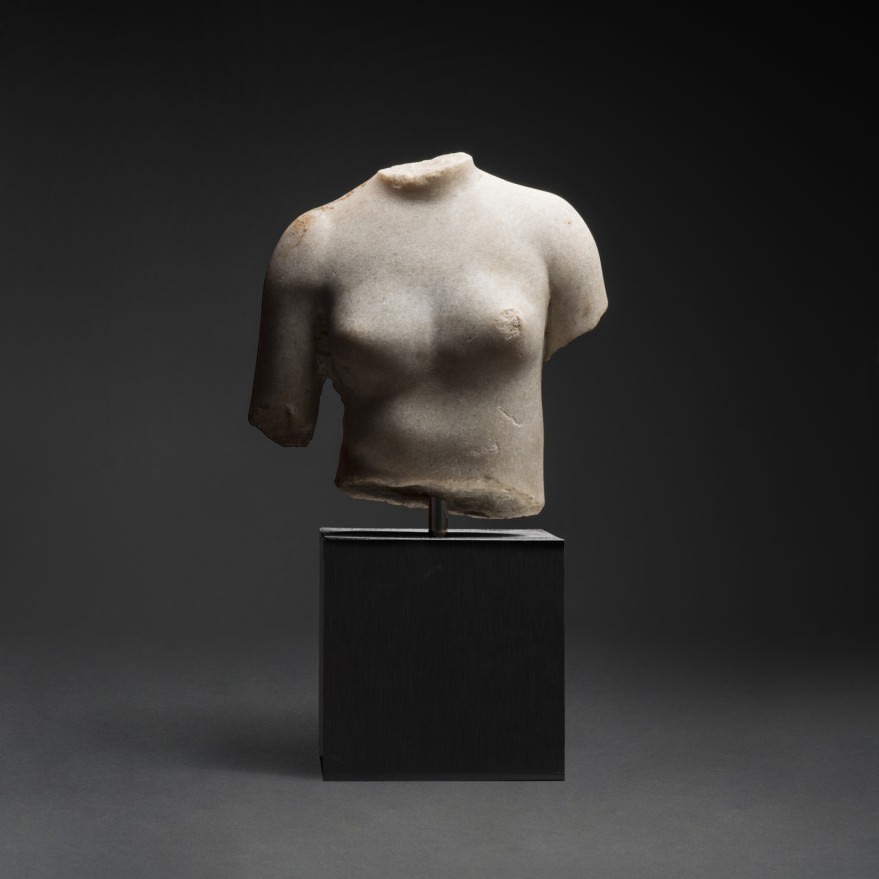Marble Torso of Aphrodite, 1 Century BCE
Marble
height 18.3 cm
height 7 1/4 in
height 7 1/4 in
LA.545
The goddess is standing with her right arm held apart from her body, her hair falling in four long tresses down below the nape of the neck. In the vast...
The goddess is standing with her right arm held apart from her body, her hair falling in four long tresses down below the nape of the neck.
In the vast Hellenic pantheon few gods enjoy such an iconic status as Aphrodite, the goddess of love, beauty, and sexual rapture. Venerated by the Romans as Venus, Aphrodite's immortal visage epitomizes the Greek standards of classical beauty that remain the aspired aesthetic of the modern day. Aphrodite has inspired countless artists throughout the centuries; since the Renaissance, the goddess has been intrinsically linked to Botticelli’s masterpiece The Birth of Venus, where the ethereal maiden rises from the sea upon the sensuous pedestal of a gaping clam.
According to Hesiod’s Theogony, Aphrodite was born from the seed of Uranus, the divine father whose genitals were cut off by his son Cronus and thrown into sea. Fermenting with the tides, a “white foam arose from the immortal flesh; with it a girl grew,” begetting Aphrodite—a full-grown woman, nubile and infinitely desirable. Fearing the jealousies that would invariably arise amongst the gods competing for her favor, Zeus cast Aphrodite to the fiery, volcanic abode of Hephaestus where she was betrothed to the deformed god of smithing. To placate his glamorous wife, Hephaestus forged marvelous jewelry that made Aphrodite even more irresistible to the hearts of men. Despite the assiduous efforts of her faithful husband, the divine seductress carried on legendary affairs with Ares, Adonis, and Anchises, the latter begetting a son, Aeneas—the Trojan hero and mythic founder of Rome. Vain, glamorous, and sadistically jealous, Aphrodite endures in Western tradition as the very avatar of beauty, elucidating the mystery of sex that was for the Greeks as perplexing as it is today.
What remains of this magnificent representation from the 1st century B.C. is a marble torso measuring just over seven inches high; though deprived of head and limb, little imagination is required to envision the lost remains of this glorious statue. Though modest in proportion, this superb relic of ancient artistry survives as a memory and testament to the Hellenic mythology so imbued in the cultural traditions of the West. With her sensuous curves and soft, gentle form, the ancient sculptor has achieved a truly remarkable feat through brilliant, polished marble—that eternal stone so emblematic of the classical age. From her youthful breasts to the delicate features running down her spine, this profoundly beautiful creation captures the eroticism and mystery befitting the goddess of love—an enviable treasure every bit as relevant today as it once was for its ancient adorer.
Ref: P. Blome, 'Basel Museum of Ancient Art and Ludwig Collection', (Geneva, 1999), p. 23, no. 18.
In the vast Hellenic pantheon few gods enjoy such an iconic status as Aphrodite, the goddess of love, beauty, and sexual rapture. Venerated by the Romans as Venus, Aphrodite's immortal visage epitomizes the Greek standards of classical beauty that remain the aspired aesthetic of the modern day. Aphrodite has inspired countless artists throughout the centuries; since the Renaissance, the goddess has been intrinsically linked to Botticelli’s masterpiece The Birth of Venus, where the ethereal maiden rises from the sea upon the sensuous pedestal of a gaping clam.
According to Hesiod’s Theogony, Aphrodite was born from the seed of Uranus, the divine father whose genitals were cut off by his son Cronus and thrown into sea. Fermenting with the tides, a “white foam arose from the immortal flesh; with it a girl grew,” begetting Aphrodite—a full-grown woman, nubile and infinitely desirable. Fearing the jealousies that would invariably arise amongst the gods competing for her favor, Zeus cast Aphrodite to the fiery, volcanic abode of Hephaestus where she was betrothed to the deformed god of smithing. To placate his glamorous wife, Hephaestus forged marvelous jewelry that made Aphrodite even more irresistible to the hearts of men. Despite the assiduous efforts of her faithful husband, the divine seductress carried on legendary affairs with Ares, Adonis, and Anchises, the latter begetting a son, Aeneas—the Trojan hero and mythic founder of Rome. Vain, glamorous, and sadistically jealous, Aphrodite endures in Western tradition as the very avatar of beauty, elucidating the mystery of sex that was for the Greeks as perplexing as it is today.
What remains of this magnificent representation from the 1st century B.C. is a marble torso measuring just over seven inches high; though deprived of head and limb, little imagination is required to envision the lost remains of this glorious statue. Though modest in proportion, this superb relic of ancient artistry survives as a memory and testament to the Hellenic mythology so imbued in the cultural traditions of the West. With her sensuous curves and soft, gentle form, the ancient sculptor has achieved a truly remarkable feat through brilliant, polished marble—that eternal stone so emblematic of the classical age. From her youthful breasts to the delicate features running down her spine, this profoundly beautiful creation captures the eroticism and mystery befitting the goddess of love—an enviable treasure every bit as relevant today as it once was for its ancient adorer.
Ref: P. Blome, 'Basel Museum of Ancient Art and Ludwig Collection', (Geneva, 1999), p. 23, no. 18.
Provenance
Acquired from Sotheby's, New York, Lot 266, Sale N08035Property of the Alice H. Decosta Revocable Trust
